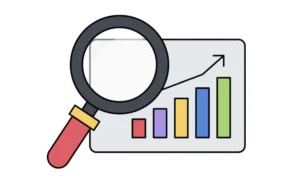The data in it is raw. The scales of measurement are the oracles of statistical mathematics that give sense and meaning to data by complicating it further. With them, we do all the things: gathering data, analyzing it, and interpreting it. Without them, all of it would be mere guesswork.
The four kinds of scales in statics speak for themselves for every point in data.
- Nominal Scale of Measurement:
- Ordinal Scale of Measurement:
- Interval Scale of Measurement:
- Ratio Scale of Measurement:
It increases power as you step up= a greater ability to understand relationships and patterns. Students in the study of statistics and professionals from different walks of life, including analytics, marketing, HR, and finance, use such scales every day.

What are Scales of Measurement in Statistics?
The scales of measurement in statistics define the classes, ranks, and comparisons of the variables. They precisely determine the statistical tools that can be used.
- Nominal- Data are only labeled or named.
- Ordinal- Data are arranged in an order.
- Interval- Equal differences between data points, but no true zero.
- Ratio- Equal differences together with absolute zero allow all mathematical operations.
Simply put: Scales of Measurement answer the three basic questions- What kind of data is it? What can I compare? What operations can I perform on it?
Nominal Scale of Measurement
What is the Nominal Scale of Measurement?
Nominal Measurement Scale is the most basic. It has only categorical disaggregation of data. It’s like according to the “name” of the data.
Key Features of Nominal Scale of Measurement
- Labels or categories only.
- No logical order.
- Number, if used, is mere symbols.
Nominal Scale of Measurement Examples
- Gender: Male, female, and other.
- Car: BMW, Tesla, and Toyota.
- Blood: A, B, AB, O.
Tip to Students/Professionals: Nominal data are the best option for frequency counts and percentages.
Ordinal Scale of Measurement
What is the Ordinal Scale of Measurement?
The Ordinal Scale of Measurement has one more added property. It aligns the meaningful order of data ranks, but with non measurable distance between ranks.
Key Features of Ordinal Scale of Measurement
- Data is ordered or ranked.
- Differences between values are not equal.
- Comparison only possible with “greater than” or “less than.”
Ordinal Scale of Measurement Examples
- Movie ratings: ★, ★★, ★★★, ★★★★.
- Class rank: 1st, 2nd, 3rd.
- Survey satisfaction: Poor, Average, Good, Excellent.
Tip: Use ordinal data for median and mode, not mean.
Interval Scale of Measurement
What is the Interval Scale of Measurement?
An Interval Measurement Scale allows for ordering data and measuring equal differences between them. The disadvantage is that there is no true zero.
Key Features of Interval Scale of Measurement
- Equal intervals.
- Zero is a matter of convention (and not absolute).
- Ratios such as “twice as much” are not valid.
Interval Scale of Measurement Examples
- Temperature Units (Celsius, Fahrenheit).
- IQ Scores.
- Calendar years (1990, 2000, 2020) . . .
Tip: Any analysis with means, standard deviations, or correlations for interval data would work.
![]() Join Our Data Analytics Telegram Channel
Join Our Data Analytics Telegram Channel
![]() Join Our Data Analytics WhatsApp Channel
Join Our Data Analytics WhatsApp Channel
Ratio Scale of Measurement
What is the Ratio Scale of Measurement?
It is regarded as the most developed. It consists of nominal, ordinal, interval properties, and a true zero.
Key Features of Ratio Scale of Measurement
- True zero exists.
- All calculations are valid.
- Ratios like ‘twice as much” make sense.
Ratio Scale of Measurement Examples
- Weight.
- Height.
- Time.
- Income.
Tip: Ratio data allows you to compute anything: mean, median, variance, advanced statistical test, etc.

Scales of Measurement Examples: Quick Comparison
| Scale of Measurement | Definition | Key Feature | Examples |
| Nominal Scale of Measurement | Labels only | Categories without order | Blood type, Car brands |
| Ordinal Scale of Measurement | Ordered categories | Ranking, unequal intervals | Movie ratings, Class ranks |
| Interval Scale of Measurement | Ordered, equal intervals | No true zero | Celsius temperature, Years |
| Ratio Scale of Measurement | Ordered, equal intervals | True zero, full arithmetic | Height, Weight, Income |
This table provides a clear comparison that gives dimensions to how the four Scales of Measurement are alike and different from each other.
Why Scales of Measurement are Important in Statistics
There is a statistical test to each corresponding scale of the measurement you use. Choose the wrong scale and watch as your entire analysis gains a way to collapse.
- Nominal & Ordinal: Perfect for qualitative research.
- Interval & Ratio: Provide power to quantitative analysis.
- From market surveys to research papers- Scales of Measurement ensure valid conclusions.
Applications of Scales of Measurement in Real Life
In Education
- Nominal: Subject names.
- Ordinal: Student rankings.
- Interval: Exam scores (scaled).
- Ratio: Study hours.
In Business
- Nominal: Customer segments.
- Ordinal: Product reviews.
- Interval: Quarterly trends.
- Ratio: Profit margins.
In Healthcare
- Nominal: Disease categories.
- Ordinal: Pain scale (Mild, Moderate, Severe).
- Interval: Temperature readings.
- Ratio: Weight and dosage.
Scales of Measurement Examples
- Nominal → Only categories (Blood type, Gender)
- Ordinal → Rank ordering (Survey ratings, Ranks)
- Interval → Equal gaps, but no zero (Temperature, IQ)
- Ratio → Equal gaps + true zero (Weight, Income)
Scales of Measurement in Data Analytics
Data analytics is assiduously accurate. Without scales of measurement, regression, clustering, or forecasting wouldn’t work correctly.
- Nominal Scale of Measurement → Classifying customer types.
- Ordinal Scale of Measurement → Measuring satisfaction.
- Interval Scale of Measurement → Tracking changes over time.
- Ratio Scale of Measurement → Calculating financial performance.
Mastering these scales is a must-have skill for any aspiring data analyst or statistician.
Also Read:
- Learn Power BI in 2025: An Effective Guide to Mastering Data Visualization
- What Is Statistical Analysis? Definition, Types, and Jobs
- From Data to Decisions: The Complete Guide to Manufacturing Analytics in 2025
- What Are Micro Frontends? Definition, Uses, and Architecture Explained: A 9 Steps Effective Guide
Build Your Data Analytics Career with PW Skills
In this Data Analytics Course, you will actually perform real-life projects that will make learning easy.
This course combines theory with the practical application of analyzing survey results and business problem-solving. Join now to start building the skill set desired by your future employers.
Interval and Ratio Scales of Measurement allow mean, while Ordinal supports median. Yes, surveys often combine nominal (gender), ordinal (ratings), and interval (scores). Because it has a true zero, which makes possible meaningful ratios and full statistical operations. Absolutely—business, psychology, economics, marketing, and healthcare all rely on them.Scales of Measurement FAQs
Which Scales of Measurement allow averages like mean and median?
Can survey data mix different Scales of Measurement?
Why is the Ratio Scale of Measurement the most powerful?
Are Scales of Measurement used outside statistics?

